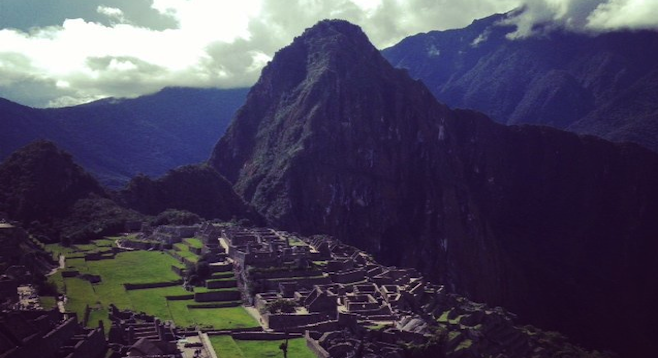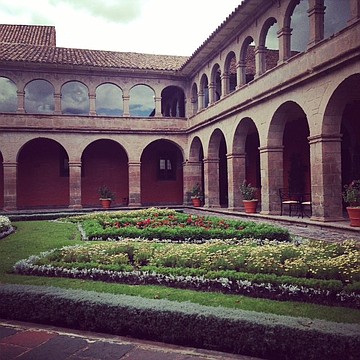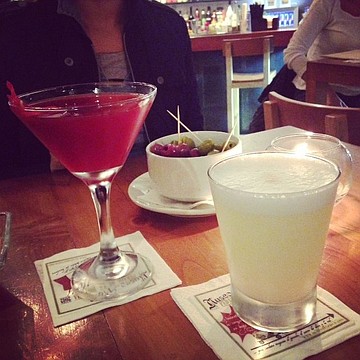 Facebook
Facebook
 X
X
 Instagram
Instagram
 TikTok
TikTok
 Youtube
Youtube

It’s a well-worn theme, that of the Inca Trail and Machu Picchu. But bear with me: this time – my fifth – we did it in luxury, an experience so alien to me as a former expedition guide and rehabilitated backpacker that it was as if I was visiting an exciting new destination for the first time.

My wife is no hiker, and I’ve recently undergone knee surgery, so the trip had to be different and special. After all, it was her 30th birthday. The Hotel Monasterio’s high ceilings, colonial architecture and ambience did not disappoint. I’m not sure how Alba managed to cope with all of my indications and pointing out of down-at-heel digs where I had, on previous occasions, laid my head. Five times, I hear you say. Yes, five times. Once as an independent fresh-faced backpacker on my Latin American sojourn in 2001, and then between 2004 and 2008 as an expedition guide for a UK company.

What’s the difference aside from the obvious? Let’s start with the smells. I live in Latin America; I am familiar with the sewer systems and the ubiquitous scent of guff that emanates. This nasal violation common to hostel drains was mercifully absent in our hotel. The opulent Hiram Bingham train, in all of its polished glory and cushioned seats, introduced us to a world where not even the shuddering of an antique railway coach over rickety tracks could make us fear the bathroom. It was a highlight. That the live band in the observation carriage played “Hotel California” before serenading my wife with Happy Birthday was even more of a thrill. (I left before they struck up a Peruvian version of YMCA.)
I think, aside from the obvious visual impact, Machu Picchu continues to draw in the crowds from all over partly due to its extreme location balanced on this mountain top, conjuring up ideas of a cloud-obscured Olympus – but also due to the fact that new research is continually changing the dialogue and the spiel dealt out by guides.
Not once in my five ascents have I heard the same explanations; they all have varied. And I used to guide here!
What are these elements that always seem to change? Well, the debate remains open as to who actually inhabited Machu Picchu, and then why it was abandoned. I was glad to hear that a theory I had long espoused about the evacuation of this mountaintop citadel took place after the arrival of the Spanish conquistadors. And then there’s the issue of the newly uncovered ruins at the deliciously named Choquequirao (pronounce it "chok ik kay rau"). This will be my next destination should I make it back here, and my guide at Machu Picchu spoke almost in raptures about it.
I kept trying to itemize the changes that had taken place in Cusco since my first visit. When I think about, it feels as if the city has become more sophisticated. Then again, this could possibly reflect on my age and the vast differences in what I was looking for here at aged 23 and now at 37.
The city appeared to be more streamlined towards a thirty-something and above crowd with money to spend. There were far more boutique shops, fine dining options and cafes. Back in 2001, I can recall that most of the central Plaza de Armas was a square string of internet cafes. Who uses an internet café nowadays? Mercifully, these locales had become restaurants and bars.

One of the few places to grab a drink in the past was the Irish Pub – still there – but we steered ourselves towards the chic Museo del Pisco for some of the more refined cocktails on offer and the headache brought about on local liquor at 11,150 feet above sea level. Starbucks was seen, acknowledged and avoided.
A guide let it slip that international soccer players plying their trade for one of the two local teams, Cienciano or Garcilaso de la Vega brought their dates here to impress.


It’s a well-worn theme, that of the Inca Trail and Machu Picchu. But bear with me: this time – my fifth – we did it in luxury, an experience so alien to me as a former expedition guide and rehabilitated backpacker that it was as if I was visiting an exciting new destination for the first time.

My wife is no hiker, and I’ve recently undergone knee surgery, so the trip had to be different and special. After all, it was her 30th birthday. The Hotel Monasterio’s high ceilings, colonial architecture and ambience did not disappoint. I’m not sure how Alba managed to cope with all of my indications and pointing out of down-at-heel digs where I had, on previous occasions, laid my head. Five times, I hear you say. Yes, five times. Once as an independent fresh-faced backpacker on my Latin American sojourn in 2001, and then between 2004 and 2008 as an expedition guide for a UK company.

What’s the difference aside from the obvious? Let’s start with the smells. I live in Latin America; I am familiar with the sewer systems and the ubiquitous scent of guff that emanates. This nasal violation common to hostel drains was mercifully absent in our hotel. The opulent Hiram Bingham train, in all of its polished glory and cushioned seats, introduced us to a world where not even the shuddering of an antique railway coach over rickety tracks could make us fear the bathroom. It was a highlight. That the live band in the observation carriage played “Hotel California” before serenading my wife with Happy Birthday was even more of a thrill. (I left before they struck up a Peruvian version of YMCA.)
I think, aside from the obvious visual impact, Machu Picchu continues to draw in the crowds from all over partly due to its extreme location balanced on this mountain top, conjuring up ideas of a cloud-obscured Olympus – but also due to the fact that new research is continually changing the dialogue and the spiel dealt out by guides.
Not once in my five ascents have I heard the same explanations; they all have varied. And I used to guide here!
What are these elements that always seem to change? Well, the debate remains open as to who actually inhabited Machu Picchu, and then why it was abandoned. I was glad to hear that a theory I had long espoused about the evacuation of this mountaintop citadel took place after the arrival of the Spanish conquistadors. And then there’s the issue of the newly uncovered ruins at the deliciously named Choquequirao (pronounce it "chok ik kay rau"). This will be my next destination should I make it back here, and my guide at Machu Picchu spoke almost in raptures about it.
I kept trying to itemize the changes that had taken place in Cusco since my first visit. When I think about, it feels as if the city has become more sophisticated. Then again, this could possibly reflect on my age and the vast differences in what I was looking for here at aged 23 and now at 37.
The city appeared to be more streamlined towards a thirty-something and above crowd with money to spend. There were far more boutique shops, fine dining options and cafes. Back in 2001, I can recall that most of the central Plaza de Armas was a square string of internet cafes. Who uses an internet café nowadays? Mercifully, these locales had become restaurants and bars.

One of the few places to grab a drink in the past was the Irish Pub – still there – but we steered ourselves towards the chic Museo del Pisco for some of the more refined cocktails on offer and the headache brought about on local liquor at 11,150 feet above sea level. Starbucks was seen, acknowledged and avoided.
A guide let it slip that international soccer players plying their trade for one of the two local teams, Cienciano or Garcilaso de la Vega brought their dates here to impress.
Comments